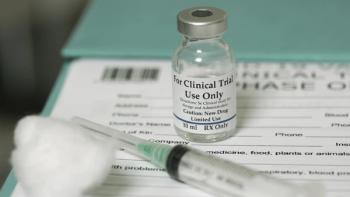
Eye care professionals report moderate-to-high satisfaction with lifitegrast treatment for dry eye
Ophthalmologists report high satisfaction with lifitegrast for dry eye treatment, noting rapid symptom relief and effective management in diverse patient populations.
The results of a cross-sectional survey that collected the real-world experiences of ophthalmologists and optometrists showed that the eye care professionals used lifitegrast ophthalmic solution 5% (Xiidra, Bausch + Lomb Americas Inc) to treat about 20% of their patients with dry eye and expressed moderate-to-high levels of satisfaction with the performance of the drug for treating the signs and symptoms of dry eye,1 according to first author Cecelia Koetting, OD, FAAO, from the University of Colorado School of Medicine, Aurora, Colorado.
She and her colleagues from institutions from across the US and Canada pointed out, “Significant improvement with lifitegrast vs placebo was observed in the symptom of eye dryness as early as day 142 and in corneal fluorescein staining at day 84.3 Previous studies have evaluated real-world treatment patterns (through June 2021) and effectiveness (through February 2020) of lifitegrast outside of the clinical trial setting.4-7 Amidst the rapidly evolving DED treatment landscape,8,9 an updated understanding of lifitegrast utilization and effectiveness in the real-world setting is needed.”
With that goal, they conducted a study to determine the experiences of practitioners with lifitegrast that included 6 ophthalmologists and 6 optometrists. The information collected included practice characteristics, lifitegrast use, satisfaction, and adverse events. The eye care practitioners were asked to rate their satisfaction with lifitegrast overall and for specific clinical outcomes vs other prescription eye drops on a scale from 1 to 10 in which 1 indicated and 10 very satisfied.
Cross-sectional survey findings
Lifitegrast was used to treat an annual mean of 1,288 (range, 35-6000) patients with dry eye, with 20.9% receiving lifitegrast.
The investigators reported, “Overall, 66.7% of [eye care practitioners] reported near/complete symptom resolution in patients after 1 to 3 months of lifitegrast treatment. The mean (range) satisfaction ratings for onset and effectiveness were, respectively, 6.8 (3-9) and 6.6 (3-9). The satisfaction with reduction of dry eye signs was generally high: increased tear film breakup time, 5.8 (3-9); reduced conjunctival/corneal staining, 6.9 (3-9); increased Schirmer test score, 6.0 (3-9); increased tear meniscus height, 6.0 (3-9); and reduced Ocular Surface Disease Index severity, 7.0 (3-10).”
They also reported the following symptom reduction satisfaction ratings: itching, 5.3 (1-9); dryness, 6.9 (3-9); burning/stinging, 6.3 (1-9); redness, 6.2 (4-9); pain, 6.3 (3-9); light sensitivity, 6.5 (3-9); and blurred/poor vision, 6.8 (4-9).
The overall satisfaction levels of the eye care providers and patients reported were, respectively, 7.1 (3-10) and 6.8 (2-9).
Lifitegrast was used predominantly to treat dry eye disease associated with contact lens wear (91.7%) and dry eye before and after refractive or cataract surgery (83.3% each). The adverse events reported were burning and stinging, blurred vision, and dysgeusia, which are known adverse effects of the drug.
Koetting and colleagues concluded, “This real-world survey showed that eye care practitioners use lifitegrast to treat approximately one-fifth of their patients with dry eye. Lifitegrast is typically used early in treatment, either alone or in combination with other prescription therapies for dry eye disease and provides rapid symptom resolution, usually within 3 months of initiating treatment. Overall, the practitioners indicated moderate-to-high personal and patient satisfaction with lifitegrast for treating dry eye disease. ECPs reported that lifitegrast is used frequently to manage dry eye disease in contact lens wearers and in patients undergoing various ocular surgeries. Adverse effects observed were mild or moderate in severity and were consistent with the known tolerability profile of lifitegrast.”
The investigators believe that their real-world survey data provide important insights into the use and effectiveness of lifitegrast in routine clinical practice.
References
- Koetting C, Schweitzer J, Nichols KK, et al. Real‑world experience with lifitegrast ophthalmic solution in patients with dry eye disease: a provider survey in the USA and Canada. Ophthalmol Ther.
https://doi.org/10.1007/s40123-025-01190-3 . - Holland EJ, Luchs J, Karpecki PM, et al. Lifitegrast for the treatment of dry eye disease: results of a phase III, randomized, double-masked, placebo-controlled trial (OPUS-3). Ophthalmology. 2017;124:53–60.
- Sheppard JD, Torkildsen GL, Lonsdale JD, et al. Lifitegrast ophthalmic solution 5.0% for treatment of dry eye disease: results of the OPUS-1 phase 3 study. Ophthalmology. 2014;121:475–83.
- White DE, Zhao Y, Ogundele A, et al. Real-world treatment patterns of cyclosporine ophthalmic emulsion and lifitegrast ophthalmic solution among patients with dry eye. Clin Ophthalmol. 2019;13:2285–92.
- White DE, Zhao Y, Jayapalan H, Machiraju P, Periyasamy R, Ogundele A. Physician satisfaction with anti-inflammatory topical medications for the treatment of dry eye disease. Clin Ophthalmol. 2020;14:931–8.
- Hovanesian JA, Nichols KK, Jackson M, et al. Real-world experience with lifitegrast ophthalmic solution (Xiidra®) in the US and Canada: retrospective study of patient characteristics, treatment patterns, and clinical effectiveness in 600 patients with dry eye disease. Clin Ophthalmol. 2021;15:1041–54.
- Karpecki P, Barghout V, Schenkel B, et al. Real-world treatment patterns of OTX-101 ophthalmic solution, cyclosporine ophthalmic emulsion, and lifitegrast ophthalmic solution in patients with dry eye disease: a retrospective analysis. BMC Ophthalmol. 2023;23:443.
- Patil S, Sawale G, Ghuge S, Sathaye S. Quintessence of currently approved and upcoming treatments for dry eye disease. Graefes Arch Clin Exp Ophthalmol. 2025;263:269–78.
- Valdes-Arias D, Locatelli EVT, Sepulveda-Beltran PA, Mangwani-Mordani S, Navia JC, Galor A. Recent United States developments in the pharmacological treatment of dry eye disease. Drugs. 2024;84:549–63.
Newsletter
Want more insights like this? Subscribe to Optometry Times and get clinical pearls and practice tips delivered straight to your inbox.














































.png)


